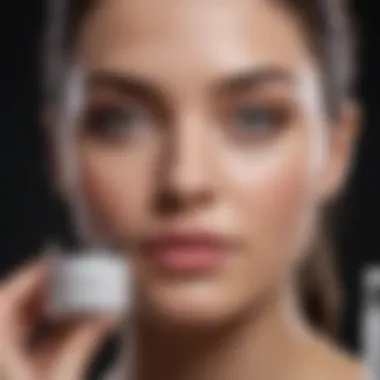The Ultimate Nighttime Guide to Retinol Serum


Intro
Retinol serum has become a staple in the skin care routines of many individuals, especially during nighttime applications. This guide aims to clarify various aspects associated with the use of retinol serum at night. Understanding the science behind retinol, how to use it effectively, and the benefits it brings can enhance your approach to skincare. In this article, you will find detailed recommendations and insights regarding preparation steps, application techniques, and aftercare.
The following sections will break down the process of integrating retinol serum into your skincare regimen in a thorough manner. By doing so, we will address common questions and concerns, along with potential side effects and best practices that can assure safety and efficacy.
Key Points Covered
- Benefits of using retinol serum at night.
- Step-by-step preparation and application process.
- Recommended post-application care.
- Common side effects and how to mitigate them.
- Tips for incorporating retinol into your skincare routine.
Understanding Retinol and Its Benefits
Understanding retinol is crucial for anyone interested in enhancing their skincare routine. This section will explore the many facets of retinol, including its definition, primary advantages, and differentiating aspects compared to other retinoids.
What is Retinol?
Retinol is a derivative of vitamin A, widely recognized for its ability to promote skin renewal and improve the appearance of skin texture. When applied topically, retinol converts into retinoic acid once absorbed by the skin. This acid then promotes collagen production, reduces the appearance of fine lines, and enhances overall skin tone. Understanding what retinol is will create a solid foundation for discussing its application and benefits.
Key Benefits of Retinol for Skin Health
Retinol offers several key benefits that make it a popular choice among skincare enthusiasts:
- Reduces Fine Lines and Wrinkles: Regular use of retinol can significantly minimize the visibility of fine lines, giving a smoother appearance to the skin.
- Improves Skin Texture: It helps in exfoliating the skin, which reveals a fresher layer beneath, improving overall texture.
- Addresses Acne Issues: Retinol is effective in unclogging pores, leading to fewer breakouts.
- Evens Skin Tone: The use of retinol can help in fading dark spots and hyperpigmentation, resulting in a more uniform complexion.
These benefits highlight why retinol is often seen as a fundamental ingredient in anti-aging and acne treatments.
Differences Between Retinol and Other Retinoids
It's essential to distinguish between retinol and other retinoids, such as tretinoin and adapalene. While all belong to the same family of compounds and share similar benefits, their potency and prescribed uses differ:
- Tretinoin is a prescription-strength retinoid that works faster and may produce results more quickly, but it is usually more irritating.
- Adapalene is also a prescription option, often used primarily for acne treatment.
- Retinol, on the other hand, is available over-the-counter and is considered gentler, making it suitable for daily use by most individuals. This characteristic makes it an appealing entry point for those new to retinoids.
Why Night Application is Essential
Applying retinol serum at night becomes critical for various reasons. The skin's behavior changes when darkness falls. Nighttime is a period devoted to restoration and healing for our bodies, including the skin. This section will elaborate on the specific reasons why night application is advantageous.
Skin Regeneration During Sleep
During sleep, the body's cellular repair processes intensify. This is the phase when skin cells work harder to regenerate and replenish. When retinol is applied at night, it complements this natural cycle. The active agents in retinol can penetrate deeply, reaching the skin layers that require revitalization. Furthermore, the tranquil environment of nighttime minimizes external interferences, allowing the serum to exert its full effect without the stressors of daylight. By applying retinol at night, users can tap into this regenerative state, giving the skin a better chance to recover and flourish.
Enhanced Absorption and Effectiveness
The application of retinol serum at night leverages the skin’s enhanced permeability. Studies indicate that the skin’s barrier function is slightly weakened during nighttime, which can significantly improve absorption rates of topical treatments like retinol. This means that the active ingredients can work more effectively, increasing the potency of the serum. Moreover, using retinol in the evening avoids any potential degradation of the product from UV radiation, ensuring that users maximize the benefits of its ingredients.
Minimized Sun Sensitivity Risks
One notable consequence of using retinol is increased sensitivity to sunlight. When retinol thins the skin’s outer layer, it can make skin more vulnerable to sun exposure, leading to potential irritation and sunburn. By applying retinol at night, users mitigate the risk of adverse reactions during daylight hours. In addition, this helps avoid the additional burden of applying sunscreen over the product, which can alter its effectiveness. Night application establishes a protective layer, allowing the skin to benefit while shielded from harmful rays.
"Using retinol at night not only promotes skin regeneration but also enhances absorption and reduces sun sensitivity, leading to optimal results."


In summary, applying retinol serum at night is essential. It aligns with the natural skin healing process, heightens effectiveness by taking advantage of the skin’s absorption capabilities, and minimizes risks associated with sun exposure. With these factors in mind, incorporating a nighttime routine with retinol is an intelligent approach for anyone looking to improve their skin health.
Preparing Your Skin for Retinol
Preparing your skin before using retinol is a vital step in ensuring optimal results. Retinol can be potent and may cause irritation if not introduced correctly. Taking time to prepare your skin can help mitigate potential side effects and enhance the effectiveness of the serum. Proper preparation involves a few key steps, including cleansing, suitable exfoliation, and assessing your skin sensitivity.
The Cleansing Routine
Cleansing your skin is the first step in the preparation process. It helps remove dirt, makeup, and excess oils that may interact with the retinol. A gentle cleanser is essential to avoid stripping the skin of its natural oils. Look for products that do not contain harsh sulfates.
After cleansing, pat your skin dry with a clean towel. This helps to retain moisture. Avoid rubbing your skin harshly, as this may cause irritation, especially since retinol can already produce sensitivity. Ensuring that your skin is clean will allow for better absorption of the retinol serum, maximizing its benefits.
Choosing Suitable Exfoliants
Exfoliating your skin before starting a retinol regimen can be beneficial. Exfoliation removes dead skin cells, allowing the retinol to penetrate deeper and work effectively. However, choosing the right exfoliant is crucial.
Opt for gentle exfoliants like lactic acid or glycolic acid. These alpha-hydroxy acids help in sloughing off dead skin without being abrasive. It is advisable to exfoliate only a few times a week and not on the nights you apply retinol, to avoid over-exfoliation which can lead to irritation.
Assessing Skin Sensitivity Levels
Understanding your skin's sensitivity is a critical aspect of preparation. Different skin types react uniquely to retinol, and assessing sensitivity helps in tailoring your routine.
• If you have sensitive skin, consider starting with a lower concentration of retinol to gauge your skin's reaction.
• Look for signs such as redness, flaking, or excessive dryness.
• Keep track of any adverse reactions and adjust frequency based on how your skin feels.
Regularly checking in with your skin will allow you to adapt your use of the retinol serum effectively. Being aware of and responsive to your skin's needs can help foster a more harmonious relationship with retinol, ultimately leading to better results.
Taking these preparatory steps seriously can pave the way for achieving desired skin goals while minimizing discomfort.
How to Apply Retinol Serum
Applying retinol serum is a pivotal step in skincare routines, especially at night. Retinol, a derivative of vitamin A, is renowned for its effectiveness in reducing signs of aging, improving skin texture, and addressing acne issues. However, understanding the proper application technique is crucial to maximize its benefits while minimizing potential side effects. In this section, we will detail the correct steps to apply retinol serum, highlight common mistakes that can compromise its effectiveness, and suggest the optimal quantity to use for visible results.
Step-by-Step Application Guide
- Cleanse Your Face: Start with a gentle cleanser to remove dirt, oil, and makeup. This prepares your skin to absorb the serum effectively.
- Pat Dry: After cleansing, gently pat your face dry with a clean towel. Do not rub, as this can irritate the skin.
- Wait Before Applying: Allow your skin to dry completely. This is important because applying retinol on damp skin can lead to increased sensitivity.
- Use a Pea-Sized Amount: Squeeze a small amount of retinol serum onto your fingertip. A pea-sized quantity is sufficient for the entire face.
- Dot and Spread: Dot the serum on your forehead, cheeks, chin, and nose. Then, use your fingertips to spread it evenly, avoiding the eye area.
- Use Gentle Motions: Apply the serum using light, upward strokes. Avoid aggressive rubbing to reduce irritation risks.
- Allow it to Absorb: Give the serum a few minutes to absorb into the skin before applying any other products. This ensures better penetration.
- Follow with Moisturizer: After the retinol has absorbed, apply your regular nighttime moisturizer. This is essential for maintaining hydration and reducing the potential dryness caused by retinol.
Common Mistakes to Avoid
Several missteps can hinder the efficacy of retinol. Be mindful of these common pitfalls:
- Using too much product: Using more than a pea-sized amount won't enhance results and may cause irritation.
- Applying on damp skin: This can increase the chances of irritation and reactiveness. Always ensure skin is completely dry.
- Neglecting moisturizer: Skipping moisturizer post-application can lead to dryness and flakiness.
- Not wearing sunscreen: Retinol makes your skin more sensitive to sun exposure. Daily sunscreen is critical to protect the skin.
Recommended Quantity for Effective Use
The amount of retinol serum you apply is directly tied to its effectiveness and the skin response. The right quantity is about a pea-sized amount for the entire face. This provides enough product to cover the skin, yet it's small enough to minimize the potential for irritation. If you experience sensitivity when starting retinol, consider applying it every other night and gradually increasing to nightly use as your skin adapts.
Consistency is key when using retinol. Gradually increasing frequency helps your skin build tolerance and maximizes the benefits over time.


Retinol can be a powerful addition to any skincare routine when applied correctly. Following these guidelines will help cultivate a healthy relationship with this powerful compound.
Post-Application Care
Post-application care is crucial following the use of retinol serum. The skin can be sensitive and may require specific aftercare practices to mitigate any potential irritation. Addressing this phase properly enhances the benefits of retinol, allowing the serum to work effectively while minimizing discomfort.
Moisturizing After Retinol Use
Moisturizing the skin after applying retinol is essential. Retinol can be drying, so applying a good moisturizer helps to restore hydration. Use a gentle, fragrance-free moisturizer to avoid further irritation. Ingredients such as hyaluronic acid and glycerin are beneficial because they help draw moisture into the skin.
- Choose products free of harsh chemicals: Look for moisturizers that are non-comedogenic and suitable for your skin type.
- Layer products appropriately: Apply your moisturizer about 20 minutes after the retinol to allow it to absorb properly. This can help reduce the feeling of dryness without diminishing retinol's effectiveness.
Using Sunscreen the Following Day
The use of sunscreen the day following retinol application cannot be overstated. Retinol increases skin sensitivity to sunlight, thus applying sunscreen is necessary to protect the skin.
- Use a broad-spectrum sunscreen: Select a sunscreen with at least SPF 30 to offer adequate protection.
- Reapply as needed: Remember to reapply every two hours if spending extended time outdoors. This keeps your skin safe from harmful UV rays, ensuring the long-term effectiveness of your skincare routine.
"Using sunscreen daily is an integral part of skin care, especially when using retinol, to prevent sun damage and maintain skin health."
Monitor Skin for Reactions
Vigilantly monitoring your skin for any reactions after retinol application is vital. Skin can react differently based on individual sensitivity, and it’s important to identify any adverse effects early.
- Look for signs of redness or peeling: Minor redness is normal in the beginning, but if it persists or increases, consider adjusting your usage.
- Consider a patch test: If you are new to retinol, applying it on a small area first can help gauge your skin’s response. This allows you to tailor your approach before full application.
- Consult a dermatologist as needed: If you experience severe irritation, seek professional advice promptly. A qualified dermatologist can provide guidance tailored to your skin’s needs.
By following these post-application care steps, you can maximize the benefits of retinol while minimizing potential side effects, thereby enhancing your overall skincare regimen.
Potential Side Effects of Retinol
Understanding the potential side effects of retinol is crucial for anyone considering its integration into their skincare routine. Adverse reactions can range from mild irritations to more serious conditions that may require professional intervention. Awareness of these effects ensures that users can navigate their usage effectively while maximizing the benefits of this powerful ingredient.
Common Reactions to Expect
When you first start using retinol, it’s normal to experience some side effects. Common reactions include:
- Redness: Skin may become slightly red or flushed shortly after application. This usually subsides within a few hours.
- Dryness and Peeling: Retinol increases cell turnover, which can lead to dryness and flakiness, especially in the initial weeks of use.
- Sensations of Burning or Stinging: Some users report a tingling feeling when applying retinol, which is generally temporary.
- Increased Sensitivity: The skin may become more sensitive to environmental factors, including sunlight and harsh weather conditions.
It’s recommended to introduce retinol gradually. Start with a lower concentration and apply it less frequently to allow the skin to acclimate. Depending on your skin type, reactions may vary, so those with sensitive skin should exercise additional caution.
When to Consult a Dermatologist
While most side effects of retinol are temporary, some situations necessitate professional advice. You should consider consulting a dermatologist if:
- Severe Irritation Occurs: If you experience excessive redness, swelling, or discomfort that does not improve after a few days, it may indicate that you need to stop usage or change your regimen.
- Prolonged Extreme Dryness: Persistent dryness or peeling despite proper moisturizing can lead to compromised skin barriers, which can necessitate professional evaluation.
- Allergic Reaction: Any signs of rash, hives, or difficulty breathing after application are serious and warrant immediate medical attention.
- Underlying Skin Conditions: Individuals with pre-existing conditions, like eczema or psoriasis, should seek a dermatologist’s guidance before starting retinol to ensure it is appropriate for their skin.
Regular communication with a skincare professional can optimize your usage of retinol and help you achieve your skin health goals safely.
Integrating Retinol into Your Skincare Regimen


Integrating retinol into your skincare regimen is pivotal for achieving optimal skin health. Retinol is a powerful ingredient known for its ability to promote cell turnvover and collagen production. However, its precise application is critical to maximize its benefits. Failing to do so may lead to suboptimal results or unwanted side effects.
Frequency of Use for Best Results
Determining the appropriate frequency for applying retinol is fundamental. Beginners should start with a conservative approach. Initially, using retinol once or twice a week is advisable. This allows the skin to acclimatize to the active ingredient. As the skin becomes more tolerant, frequency can be gradually increased to three or four times a week.
It's essential to observe how your skin reacts to retinol. Signs of irritation such as redness, peeling, or excessive dryness may indicate the need to scale back. On the other hand, if the skin responds positively, consistent use will yield superior results over time.
"Consistency is key; regular use enhances the benefits of retinol, contributing to smoother and healthier skin."
Adjusting Your Routine for Retinol
Adjusting your skincare routine to incorporate retinol should be done thoughtfully. It is important to consider the other products you are currently using. For instance, combining retinol with other potent actives such as alpha hydroxy acids or vitamin C at the same time might lead to irritation. Instead, consider alternating these ingredients. Use retinol at night and apply your acids or vitamin C in the morning.
Moreover, since retinol can cause dryness, it is wise to introduce a hydrating serum or moisturizer into your regime. Look for ingredients like hyaluronic acid or glycerin, which can deeply hydrate the skin. This strategy can mitigate the dryness while ensuring that the benefits of retinol are still fully realized.
Pay attention also to environmental factors. If using retinol during colder months, you might need to modify your moisturizer to a richer formulation to combat seasonal dryness.
Alternatives to Retinol Serum
Finding suitable alternatives to retinol serum can be quite beneficial for those seeking to improve their skin health without experiencing the potential drawbacks of retinoid use. While retinol is known for its powerful anti-aging properties, some individuals may have skin sensitivities or prefer gentler options. Thus, understanding and exploring these alternatives ensure that everyone can find a suitable option for their skincare regimen. Here, we will discuss other effective ingredients and natural alternatives for those with sensitive skin.
Other Effective Ingredients
Several ingredients can provide similar benefits to retinol without some of the harsh side effects. Here are some noteworthy alternatives:
- Bakuchiol: This plant-based ingredient is often touted as a natural retinol alternative. Studies have shown it to improve skin elasticity, reduce fine lines, and enhance overall skin tone. Bakuchiol has the advantage of being less irritating, making it suitable for those with sensitive skin.
- Peptides: Known for promoting collagen production, peptides help improve skin texture and firmness. They work on a cellular level to repair skin, making them a good option for those wishing to combat wrinkles without the irritation sometimes associated with retinol.
- Alpha Hydroxy Acids (AHAs): AHAs, such as glycolic and lactic acid, exfoliate the skin and stimulate cellular turnover. They enhance absorption of other skincare products and can smooth the skin’s surface, which is beneficial for those seeking anti-aging effects.
- Beta Hydroxy Acids (BHAs): Salicylic acid is well-known for its ability to penetrate pores and is effective in treating acne. In addition to that, it promotes exfoliation and skin renewal, which can also reduce the appearance of fine lines over time.
These ingredients stand out due to their effectiveness and ability to address various skin concerns, providing individuals more choices tailored to their unique skin needs.
Natural Alternatives for Sensitive Skin
For those with especially sensitive skin, opting for gentle and natural alternatives is essential. Below are some options that are known for being effective, yet mild:
- Rosehip Oil: High in vitamin C and fatty acids, rosehip oil offers antioxidant protection while providing hydration. It can help reduce signs of aging and improve skin texture without irritation.
- Hyaluronic Acid: While it does not have retinol-like exfoliating properties, hyaluronic acid is excellent for hydration. It attracts moisture to the skin and can plump fine lines, making it suitable for sensitive skin types that need hydration without irritation.
- Niacinamide: Also known as vitamin B3, niacinamide is effective in improving skin tone and texture. It helps regulate oil production and has anti-inflammatory properties, which make it an excellent option for sensitive or acne-prone skin.
- Green Tea Extract: This ingredient offers powerful antioxidant properties and can calm skin inflammation. It is a good option for those who want to improve skin health without harsh chemicals.
The End
The conclusion is a vital part of this article. It serves not just to summarize, but also to emphasize the significance of incorporating retinol serum into one's nightly skincare routine. With its ability to rejuvenate the skin, retinol provides various benefits, including reducing fine lines, improving texture, and enhancing luminosity. This section aims to reinforce the messages presented earlier while motivating the reader to take action.
Review of Key Points
In reviewing the key points, it is essential to highlight the various benefits of retinol, particularly when used at night. Users should recognize that:
- Retinol enhances skin cell turnover, leading to a fresher complexion.
- Night application is preferred due to the skin's natural regeneration process during sleep.
- Proper preparation steps, such as cleansing and assessing skin sensitivity, are critical to achieving optimal results.
- Following a precise application technique can help minimize side effects and maximize benefits.
- Post-application care, including moisturizing and using sunscreen the next day, is vital in protecting the skin.
These takeaways encapsulate the article's core messages and prepare the reader to initiate or refine their retinol journey.
Encouragement for Consistency
Consistency is the cornerstone of success in any skincare regimen. Incorporating retinol serum regularly can lead to cumulative benefits over time. Readers should be encouraged to:
- Start slowly and gradually increase application frequency based on skin tolerance.
- Maintain a regular night routine, as regular use allows the skin to adapt and thrive.
- Commit to assessing their skin’s response and make adjustments when necessary.
Establishing a consistent habit will facilitate visible improvements, reinforcing the notion that perseverance is key to realizing skin goals.
"The road to radiant skin requires patience and dedication."







